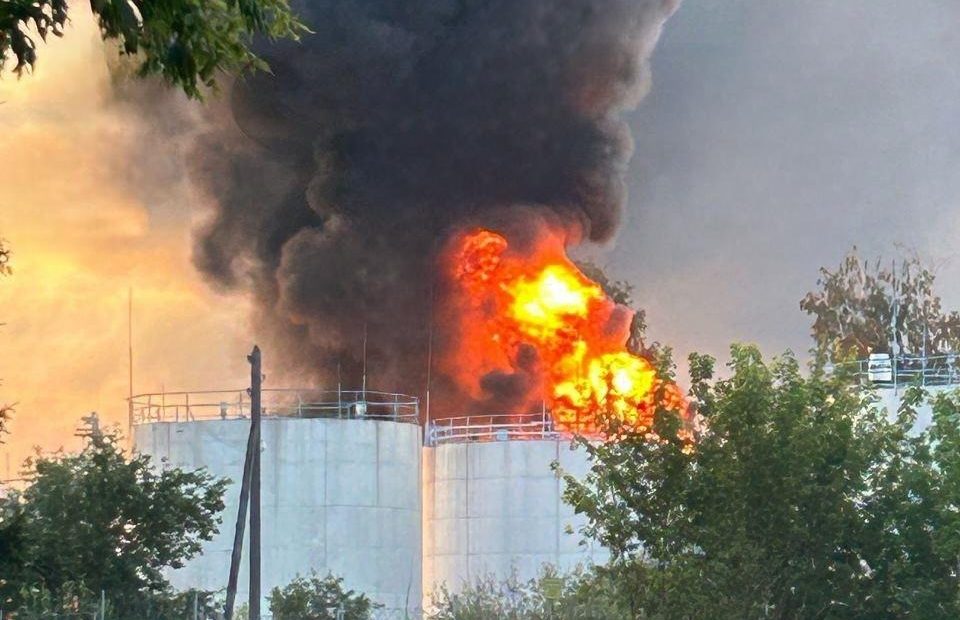MOSCOW — Russian authorities battled for a third consecutive day Tuesday to extinguish a massive fire at an oil depot in the southern Rostov region, ignited by a Ukrainian drone attack. Simultaneously, Ukrainian forces expanded their incursion into Russia’s Kursk region, marking a significant escalation in the ongoing conflict.

The fire at the oil depot in Proletarsk has engulfed an area of one hectare (2.5 acres), according to Russian state news agencies. The firefighting operation has grown to involve 500 personnel, with 41 firefighters hospitalized due to injuries, the state-owned TASS news agency reported, citing local officials.
Ukraine’s Army General Staff claimed responsibility for the attack on Sunday, stating it was a strategic move “to undermine the military and economic potential of the Russian Federation.” The depot was reportedly used to supply the Russian army’s needs.
Hundreds of kilometers northwest, Ukraine continued its unprecedented operation in Russia’s Kursk region, which began two weeks ago. Ukrainian President Volodymyr Zelenskyy reported significant gains, both in territory and in the capture of Russian prisoners.
“Overall, this (Kursk) operation became our largest investment in the process of freeing Ukrainian men and women from Russian captivity,” Zelenskyy told diplomats on Monday, according to a statement published on Telegram. “We have already captured the largest number of Russian prisoners in one operation.”
Zelenskyy claimed that Ukrainian forces have seized control of 1,250 square kilometers (480 square miles) and 92 settlements in Russia’s Kursk region.
The Institute for the Study of War, a Washington-based think tank, corroborated these claims, reporting that Ukrainian forces “continued to marginally advance” in Kursk on Monday.
The incursion into Kursk, described as the largest attack on Russia since World War II, has exposed vulnerabilities in Russia’s defenses under President Vladimir Putin’s leadership.
Zelenskyy emphasized the strategic importance of these operations, stating, “Our defensive actions across the border, as well as Putin’s inability to defend his territory, are telling.”

TASS reported 17 deaths and 140 injuries resulting from Ukraine’s incursion, citing an unnamed source in the Russian medical service. Of the 75 people hospitalized, four are children.
Ukraine’s tactical approach in Kursk has included targeting key infrastructure. Ukrainian and Russian reports suggest that at least three bridges over the Seym River in the Kursk region have been destroyed or damaged. This strategy could potentially trap Russian forces between the river, the Ukrainian advance, and the Ukrainian border.
Satellite imagery analyzed by The Associated Press confirmed the destruction of a bridge in the town of Glushkovo. A Russian military investigator acknowledged on Monday that Ukraine had “totally destroyed” one bridge and damaged two others in the area.
The satellite images also revealed the presence of pontoon bridges along the Seym River, likely constructed by Russian troops to maintain supply lines to forces facing the Ukrainian advance.
While Ukraine celebrates successes in Kursk, the situation in the Donbas region of eastern Ukraine remains critical. Russian forces are advancing toward Pokrovsk, a key Ukrainian defensive stronghold and logistics hub in the Donetsk region. The capture of Pokrovsk would significantly compromise Ukraine’s defensive capabilities and supply routes in the area.
Russia’s six-month campaign across Ukraine’s Donetsk region, following the capture of Avdiivka, has resulted in heavy losses for both sides in terms of troops and equipment.
Russia’s stated aim remains the capture of the entire Donetsk and neighboring Luhansk regions, which together comprise the Donbas industrial area.
As the conflict continues to evolve on multiple fronts, both inside Ukraine and within Russian territory, the international community watches closely.
The unprecedented nature of Ukraine’s incursions into Russia and the ongoing struggles in eastern Ukraine underscore the complex and dynamic nature of this prolonged conflict.



